|
|
| |
BULGARIA
CITIES AND TOWNS
SOFIA
“ Ever growing, never ageing"- this is the motto inscribed on the coat-of-arms of the Bulgarian capital – the city of Sofia.
Late last century Sofia totalled only 12,000 residents. In 1946 – 516,000 residents, and today - some 1,200,000 residents, i.e. 14 % of the country’s population. Drawing a balance, one sees that in the past 100 years the population multiplied 100 times.
This is one of the oldest towns not only in Bulgaria but also throughout Europe. “Sofia” is the fifth name of the town – following Serdica, Ulpia Serdica, Sredetz, and Triaditza. There are data on Serdica’s existence of 5,000 years ago, and the earliest written data for residents on the lands of Serdica date back to the middle of the first millennium BC. The history of today’s city of Sofia started with the founding of the Thracian town of Sardonopolis. “Serdica” (the emphasis being on the last syllable) is the oldest name of the town we know. The name originates from “Serdi” – one of the 22 Thracian tribes forming the numerous Thracian people.
Located in the fertile Sofia valley, in the very centre of the Balkan Peninsula, on the strategic crossroads between East and West, the town was a much-attractive centre for many tribes and nations, travellers and conquerors. This was why it repeatedly experienced periods of upheaval and decay, but always managed to revive anew from the ashes – like the Phoenix bird, even more magnificent and powerful.
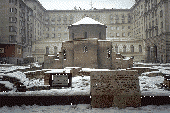 Here people venerated especially strongly god Asclepius (or Aesculapius) since on the territory of Serdica there were numerous warm mineral water sources, called Thermi.
Serdica reached its peak under Emperor Constantine the Great (306 – 337 AD).
In 6 and 7 centuries Slavonic tribes started settling in the Balkans and in the Sofia plain.
In 809 AD khan Krum besieged and overtook Serdica. Ever since the town linked its fate for good with the Bulgarian state.
In late 9 c. – under the reign of tsar Boris the town assumed the Slavonic name of Sredetz – meaning “in the middle” of the Balkan Peninsula.
In 1194 AD the town of Sredetz joined the confines of the Second Bulgarian kingdom. There followed a period of long-lasting peace and upheaval of the material and spiritual culture. In Medieval Sredetz a literary school was set up with the “St. Sophia” Church, while in 1259 AD the greatest work of the Bulgarian Middle Ages came to life – the Boyana Church murals.
At the end of 14 c. AD the town of Sredetz assumed the name Sofia. This name was linked with the biggest for that time and most beautiful “St. Sophia” Church, The name is first mentioned in a charter by Tsar Ivan Shishman (1371 – 1393 AD).
During the Ottoman rule the town was the capital of the Rumelian beyler-bey office, encompassing almost all the territory of the Balkan Peninsula. Preserved from that age now are the “St. Petka Samardjiiska” Church (in the subway in front of TSUM, the “Sheraton” hotel”) and the “St. Spas” (Ascension) Church (within the architectural ensemble of “Bulbank”).
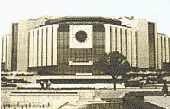
An important fact of Sofia’s history was its proclamation for capital of Bulgaria after the liberation from Ottoman domination (on a proposal by the prominent public figure Marin Drinov) with a Decree by the first Bulgarian prince Alexander Battenberg on April 3, 1879.
PLOVDIV
Lucina the Greek called Plovdiv "the biggest and most beautiful of all
towns" in
Thrace. With a population of 400.000 it is Bulgaria's second largest city. The old town embodies Plovdiv's long and varied history - The Thracian fortifications used by Macedonian masons and overlaid with Byzantine walls and great timber-framed mansions erected during the Bulgarian Renaissance look down on the Ottoman mosques and artisan's homes of the lower town.
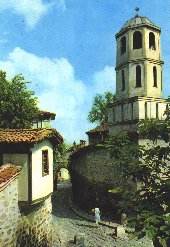 There are still remains to be seen today of Plovdiv's historical position as a crossroads between East and West, among them the city Forum, the amphitheatre of Philip II of Macedonia, basilicas, thermae, merchants' houses and administrative buildings. With the restoration of the 2nd century theatre, performances are again given in this 3.000 seater monument of history.
Plovdiv's showcases are the dozens of National Revival style houses, which are an excellent example of this style at the time at its height. They were built on an incline, expanding storey by storey using timber-framed oriels, thus cleverly solving the problem of available ground and the merchants' demand for roomy interiors in the 19th century.
VELIKO TURNOVO
The royal city of Veliko Tarnovo, once capital of the Second Bulgarian Empire, is situated on three hills encircled by the Yantra river which cuts into the countryside. The sheer cliffs are home to houses, perched one on top of another, right down to the river's bank.
The main hill, Tsarevets, was a natural inaccessible fortress on which the royal palace, the patriarchate and the many domed churches were built. At night, the floodlit ramparts and the Patriarchate, and what remains of the palace and churches, convey something of the grandeur of the city once renowned as being "second only to Constantinople".
To the south east of Tsarevets stands the restored Baldwin Tower, built to commemorate
the Bulgarian Tsar Kaloyan's victory over the knights of the Fourth crusade in 1205.
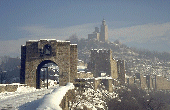 To the west on the Yantra lies the Assenova quarter, once an artisan quarter during the Middle Ages, nestling beneath the imposing Trapesitza massif. Here the bolyari and leading clergy of the Second Empire built their mansions and private churches, and today many are suc-cessfully excavated.
On the south bank of the Yantra stands Sveta Gora. This was once the country's spiritual and cultural centre. The Turnovo school of literature and painting gave the world the Manassieva Chronicle and the Tetraevangelis of Tsar Ivan Alexander, while its traditions played an influential role in south western Europe.
Besides being a medieval capital. Turnovo was also a National Revival city where some of the finest work of Kolyo Ficheto, the master builder, is to be seen, and where the 18- 19th century houses seem to grow right out of the steep slopes flanking the river, The many churches still standing and in use, such as St. 40 Martyrs, Sts. Peter and Pavel and the church of the Holy Virgin. are a splendid example of Bulgaria's architecture.
THE VILLAGE OF ARBANASSI
Arbanassi is one of Bulgaria's most picturesque villages. It lies hidden on a plateau 4 kilometres north east of Turnovo and some of the many monasteries built during the Second Empire still stand today. It is thanks to the merchants Investments here that the village has so much to offer, with its large stone-built houses, notably the Konstantsaliev house, and churches, chapels and fountains with drinking water.
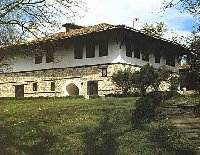 It quite naturally became a lively urban centre for Christians, hidden from the eyes of the Turkish ruled Turnovo.
TRYAVNA
Although Tryavna is an old crafts' centre with no less than 140 listed buildings, it is not however a typical museum town, since its position on the mountain slopes has ensured its unspoiled beauty. The whole town exudes
an air of the National Revival period. Wandering through the narrow streets one cannot help but notice the richly designed woodcarvings, which abound both inside and outside the houses.
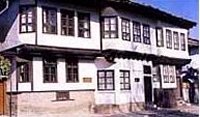 Besides the interesting exhibitions to be seen in the homes of National Revival figures such as Angel Kanchev, Petko and Pencho Slaveykov, is the Daskalov's House built in 1804, which has been turned into an ethnographic muse-um. The distinctive style of the 19th century Tryavna school can be viewed in the Museum of Icon Painting and Woodcarving.
BOZHENTZI
Lying between Gabrovo and Tryavna, Bozhentzi boasts superb examples of 19th century dwellings. During the latter part of that century it prospered thanks to its smiths. potters and weavers and the local merchants who traded as far afield as Russia and Hungary. Today it is better known among the artistic circles as a holiday retreat.
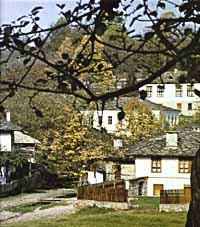 The village now has well over 100 listed buildings., ranging from the grandeur of a wool merchant's house to the humble dwelling of a rural peasant of that time. and also today's artisan workshops. In this tranquil atmosphere it seems as if time has stood still these past two centuries, with nothing but fresh mountain air and quaint white-washed houses covered in seasonal flowers and roofed with heavy stone tiles.
KOTEL
The town of Kotel lies in a small valley in the Balkan range which links north and south Bulgaria. Renowned for its spirit of the National Revival, it is famous as a centre for carpet-making, and a wide selection of antique and modern carpets and tapestry icons in the spirit of medieval frescos are on exhibit in the village.
Here the National Revival houses were built of wood, something more particular to the Eastern Balkans, the only difference being that they are higher, up to 3 or 4 storeys high. Besides an ethnographic museum, there are some beautifully preserved houses, including the Kosichkov, Pisomov, Burnev, Bairumov and Karaivanov houses, the old water mill and an inn.
ZHERAVNA
The village of Zheravna is set on the beautiful southern slopes of two small hills in the Eastern Balkan range. The spacious wooden houses, surrounded by stone walls with nail-studded doors as entrances, date from as early as the 17th century, when sheep breeding and various crafts were the main activities. There are fine examples of woodcarving to be seen here, notably in the Sava Yovkov House.
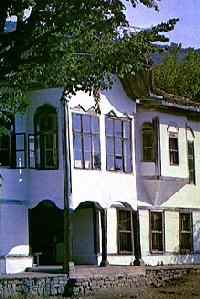 Many of Bulgaria's artists' houses are open to the public, including that of Yordan Yovkov the novelist and Rusi Chorbadzhi. While the older houses were entirely wood built, later houses had their ground floors built of stone.
The houses' interiors are awash with colour and artisan work, and mirror the pride felt by Bulgarians for their homes and the special place they have in their lives.
KOPRIVSHTITSA
Koprivshtitza is one of Bulgaria's best preserved towns and its typical 19th century atmosphere along with its natural surroundings make it a must on every visitor's list. While the romantic atmosphere of previous centuries lingers on, it is interesting to note that the first shot fired during the 1878 April uprising against the Ottoman Empire was fired here.
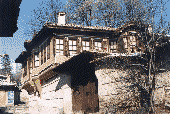 Eminent political and social figures lived in this town where the evolution of Bulgaria's National Revival architecture is apparent wherever you look. The town is perhaps best known for its Great Koprivshtitza Folklore Festival, held every five years.
MELNIK
In the Southwest of the Pirin Mountain stand the Melnik Pyramids - sheer, strangely shaped sand and limestone rocks. And here amongst this breathtaking scenery you will find Melnik, one of Bulgaria's smallest towns. Hidden by a seemingly impenetrable mountain wall, the village was able to withstand the effects of the Byzantine Empire in the 11th century. And yet once there, you find yourself in an attractive main square with taverns and timber propped whitewashed stone houses leading off to cobbled streets and courtyards where flowers and vines adorn the facades.
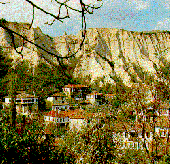 In the 17th and 18th centuries Melnik flourished as a tobacco and wine growing community, whose strong red wine was drunk as far afield as France, Spain, Italy and Austria.
BANSKO
One of the prettiest Pirin mountain towns, Bansko is situated at the foot of the Pirin Mountain and right below the Pirin National Park, a world national heritage site, although in recent years Bansko has also become known as a winter sports resort. Here the old lives hand in hand with the new, where the modern centre gives off onto small cobbled streets with timber framed houses sheltering behind stout double doors.
Bansko's architectural heritage is best seen in master builder, woodcarver and painter Velin Ognyanov's work. He rebuilt the Sirleshtova House in the late 18th century and the Velyanova House around the turn of the 19th century.
|
|
|
Festivals and Fairs
The Great Koprivshtitza Folklore Festival
The Great Koprivshtitza Folklore Festival is Bulgaria's largest gathering of traditional musicians and singers and is a cross between a pop festival and a medieval fair. It is a sight that knows no equal: thousands of musicians and singers making the hillside above the picturesque village of Koprivshtitza their home for a few days. Coupled with this you have the colourful stalls of the traders and the thousands of visitors who come for the festival.
This is Bulgarian music as it was always played, played by the ancestors of those who first played it. But perhaps it is what happens on the periphery that is the most authentic. Strolling players or soloists, simply playing for the sheer enjoyment. forming new bonds with other musicians or just letting their music ring out over the hillside.
The Bourgas International Folk Festival
The Bourgas International Folk Festival, held annually, attracts a host of Bulgarian and international artists and is held in the second half of August.
The Kazanluk Festival
The Kazanluk Festival of the Roses is held annually in early June, and has grown from a local to an international event. Not only are the roses, Kazanluk's main industry, in full flower. but the town itself blossoms while visitors enjoy the "Rose Picnic" and all the fun of a folklore festival, with its costumes, songs and dance. Should you still have the energy left, you can always visit the old factories where the rose oil is extracted.
St. Trifon's Day
In the agricultural calendar, St. Trifon's Day celebrates the pruning of the vines, and is held on February 14.
Kukerov Den
On the first Sunday before Lent, Kukerov Den celebrates the start of the agricultural year, and all over Bulgaria you can witness processions led by the dancing. leaping Kukeri dressed in colourful masks and costumes.
Baba Marta
Baba Marta is celebrated on March 1 when peasant house-holds brush out the winter cobwebs with a traditional spring clean. and people offer each other tokens of good luck called martenitsas.
Kukeri
Like western countries. the Bulgarian calendar is dotted with important feast days and festivals. The festival of the Kukeri re-enacts ancient surovaki rites to ward off evil spirits and Kukeri fertility rites. Although only held once every five years, it brings together dancers from all over Bulgaria in a rainbow of colours and styles.
St. Lazarus Day
Lazaruvane is also celebrated in spring on St. Lazarus Day, and here village girls considered fit for marriage perform ritual songs and dances.
St. Konstantin and St. Elena Day
The coming of summer is traditionally celebrated on St. Konstantin and St. Elena Day on May 21, and in some of the remoter villages in the Stranzha hills fire dancing, dancing on heated coals, is still practised in celebration of summer's arrival. Ethnologists have suggested that this practice is directly descended from Dionysina rites of the ancient Thracian.
|